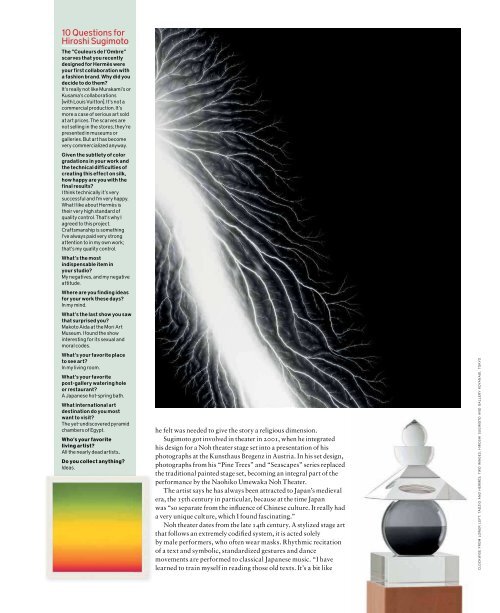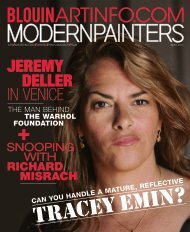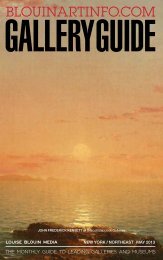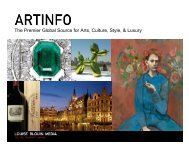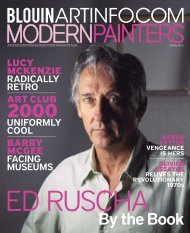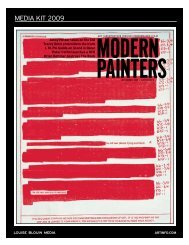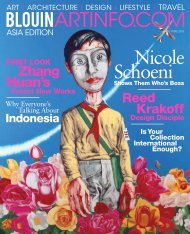Linke - Artinfo
Linke - Artinfo
Linke - Artinfo
Create successful ePaper yourself
Turn your PDF publications into a flip-book with our unique Google optimized e-Paper software.
10 Questions for<br />
Hiroshi Sugimoto<br />
The “Couleurs de l’Ombre”<br />
scarves that you recently<br />
designed for Hermès were<br />
your first collaboration with<br />
a fashion brand. Why did you<br />
decide to do them?<br />
It’s really not like Murakami’s or<br />
Kusama’s collaborations<br />
[with Louis Vuitton]. It’s not a<br />
commercial production. It’s<br />
more a case of serious art sold<br />
at art prices. The scarves are<br />
not selling in the stores; they’re<br />
presented in museums or<br />
galleries. But art has become<br />
very commercialized anyway.<br />
Given the subtlety of color<br />
gradations in your work and<br />
the technical difficulties of<br />
creating this effect on silk,<br />
how happy are you with the<br />
final results?<br />
I think technically it’s very<br />
successful and I’m very happy.<br />
What I like about Hermès is<br />
their very high standard of<br />
quality control. That’s why I<br />
agreed to this project.<br />
Craftsmanship is something<br />
I’ve always paid very strong<br />
attention to in my own work;<br />
that’s my quality control.<br />
What’s the most<br />
indispensable item in<br />
your studio?<br />
My negatives, and my negative<br />
attitude.<br />
Where are you finding ideas<br />
for your work these days?<br />
In my mind.<br />
What’s the last show you saw<br />
that surprised you?<br />
Makoto Aida at the Mori Art<br />
Museum. I found the show<br />
interesting for its sexual and<br />
moral codes.<br />
What’s your favorite place<br />
to see art?<br />
In my living room.<br />
What’s your favorite<br />
post-gallery watering hole<br />
or restaurant?<br />
A Japanese hot-spring bath.<br />
What international art<br />
destination do you most<br />
want to visit?<br />
The yet-undiscovered pyramid<br />
chambers of Egypt.<br />
Who’s your favorite<br />
living artist?<br />
All the nearly dead artists.<br />
Do you collect anything?<br />
Ideas.<br />
he felt was needed to give the story a religious dimension.<br />
Sugimoto got involved in theater in 2001, when he integrated<br />
his design for a Noh theater stage set into a presentation of his<br />
photographs at the Kunsthaus Bregenz in Austria. In his set design,<br />
photographs from his “Pine Trees” and “Seascapes” series replaced<br />
the traditional painted stage set, becoming an integral part of the<br />
performance by the Naohiko Umewaka Noh Theater.<br />
The artist says he has always been attracted to Japan’s medieval<br />
era, the 15th century in particular, because at the time Japan<br />
was “so separate from the influence of Chinese culture. It really had<br />
a very unique culture, which I found fascinating.”<br />
Noh theater dates from the late 14th century. A stylized stage art<br />
that follows an extremely codified system, it is acted solely<br />
by male performers, who often wear masks. Rhythmic recitation<br />
of a text and symbolic, standardized gestures and dance<br />
movements are performed to classical Japanese music. “I have<br />
learned to train myself in reading those old texts. It’s a bit like CLOCKWISE FROM LOWER LEFT: TADZIO AND HERMÈS; TWO IMAGES, HIROSHI SUGIMOTO AND GALLERY KOYANAGI, TOKYO<br />
clockwiSe froM lower left: tadzio and herMÈS; two iMageS, hiroShi SugiMoto and gallery koyanagi, tokyo<br />
odawara art foundation and Shinji MaSakawa<br />
Shakespeare, maybe a little harder,” Sugimoto laughs.<br />
The Guggenheim Museum in New York is currently presenting<br />
“Gutai: Splendid Playground,” a retrospective exhibition of the<br />
Gutai Art Association (1954–72), a radically inventive, influential<br />
Japanese art collective and movement. As part of this retrospective<br />
and as a tribute to the spirit of Gutai, “Sanbaso: Divine Dance”<br />
will be performed on March 28 and 29.<br />
Sugimoto explains that the presentation will be traditional<br />
with a contemporary twist. He is replacing the pine-tree landscape<br />
associated with Noh theater with two panoramic banners from<br />
his “Lightning Field” photographic series, representing the chaotic<br />
era of the play. The dance will be performed once more this spring,<br />
on April 26 at the Shibuya Cultural Center in Owada, Japan.<br />
Sugimoto’s support for the traditional performing arts runs<br />
deep. In 2009, he set up the Odawara Art Foundation to produce<br />
and support classic theater forms. The artist is keen to bring Noh<br />
theater back into its traditional performance setting—outdoors—<br />
Blouin<strong>Artinfo</strong>.comAsiA | march/april 2013<br />
Clockwise from<br />
opposite page, far<br />
left: Couleurs<br />
de l’Ombre scarf<br />
107, designed by<br />
Sugimoto for<br />
Hermès; Lightning<br />
Fields 222, 2009,<br />
from one of<br />
the artist’s<br />
ongoing<br />
photographic<br />
series; star<br />
kyogen actor<br />
Mansai Nomura,<br />
wearing a<br />
lightning-inspired<br />
costume by<br />
Sugimoto in a<br />
performance of<br />
“Sanbaso: Divine<br />
Dance”; Five<br />
Elements:<br />
Tyrrherian Sea,<br />
Positano, 2011,<br />
composed of<br />
clear optical glass<br />
and inlaid<br />
seascape film<br />
taken by<br />
Sugimoto in 1990.<br />
and the foundation is currently building a theater in Odawara<br />
that Sugimoto hopes will be finished in 2016.<br />
“It has been designed to show traditional Noh theater, but it<br />
could be used for any performance, including contemporary ones.<br />
It’s more in the 15th-century style: outside and open, for people<br />
to gather around a very small stage, only five meters square. It will<br />
be quite intimate, with real pine trees everywhere,” he explains.<br />
While in Paris for the October performances of The Love<br />
Suicides at Sonezaki, Sugimoto will also present a video at<br />
the Pierre Bergé–Yves Saint Laurent Foundation: Accelerated<br />
Buddha, a version of his 1995 video, Sea of Buddhas, re-edited<br />
using the latest digital technologies. In November, he opens a<br />
retrospective at the Leeum Samsung Museum of Art in Seoul.<br />
Sugimoto points out that beyond Noh and bunraku, there’s still<br />
one more traditional form of Japanese theater for him to tackle:<br />
kabuki. “I’m just conquering them one by one,” he said, admitting that<br />
he’s already thinking about how he will approach this next challenge.<br />
59


